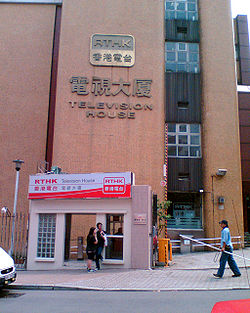- Commercial Television (TV station)
-
 Commercial Television's building from 1975 to 1978; now RTHK's Television House.
Commercial Television's building from 1975 to 1978; now RTHK's Television House.
Commercial Television (Chinese: 佳藝電視) was the third free-to-air broadcast television station in Hong Kong. It first went on air in 1975, and ceased transmissions in 1978.
History
In 1973, the Hong Kong Government decided to issue licenses for additional terrestrial television broadcasters, ending TVB's six-year monopoly as the sole free-to-air television company in Hong Kong.[1] A group of shareholders formed a consortium (Commercial Television) to contest the license; the six major shareholders were Commercial Radio, Jardines, Sing Tao Daily, Wah Kiu Yat Pao, Industrial and Commercial Daily, and the Lam family (one of the founders of Hang Seng Bank).
The licenses were awarded on 10 August, with Rediffusion Television receiving licenses for two television stations (one broadcasting in Cantonese and the other in English), while Commercial Television only received one license for a station broadcasting in Cantonese.
The station launched at 6:00pm on 7 September 1975. Its logo was a hexagon formed from six angled lines, representing the Six Arts in Confucian philosophy, as well as the six major stakeholders.
Part of the station's licensing conditions was to air two hours of educational programming on every weeknight, with no commercial interruptions. Such programming on the station was primarily oriented at adults, covering topics such as automechanics, interior design, and foreign languages[2]. The station struggled to break even as a result of this requirement. An attempt was made to resurrect the ailing station in July 1976 when Selina Chow, then Assistant General Manager of TVB was drafted in to be its new General Manager. A significant amount of money was spent on producing drama series; The number of staff trebled, and the cash-burn rate escalated under Chow[3].
On 22 August 1978, the station announced it was ending its operations, its 800 staff were laid off[3] and the company was declared bankrupt on 19 October[4]. Following the station's collapse, the government concluded that a third commercial television station "did not appear viable"[3]. It never re-issued the license, and TVB and Rediffusion Television (now Asia Television) remained a duopoly of terrestrial TV broadcasters in Hong Kong.
Much blame flew around about the reasons for the failure. The Government was blamed for restrictive conditions of the license; the management was blamed for bad program scheduling and failing to control cost escalation; shareholders were blamed for having the short-term mentality of property developers. However, the Government blamed the collapse on the unwillingness of the shareholders to inject more capital, after it had spent its entire HK$ 20 million within one year[3].
The station's building on Broadcast Drive was briefly used by TVB as a studio building, until it became RTHK's Television House in 1987.
References
Categories: Hong Kong television | History of Hong Kong | Television channels and stations established in 1975 | 1978 disestablishments
Wikimedia Foundation. 2010.


